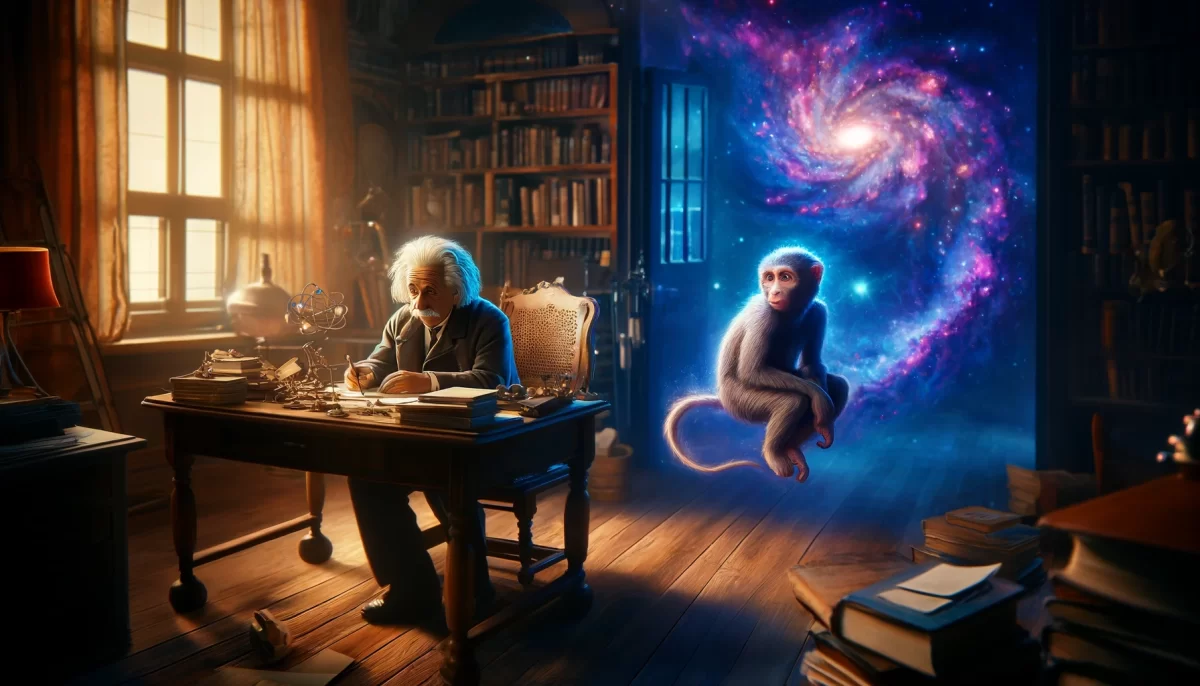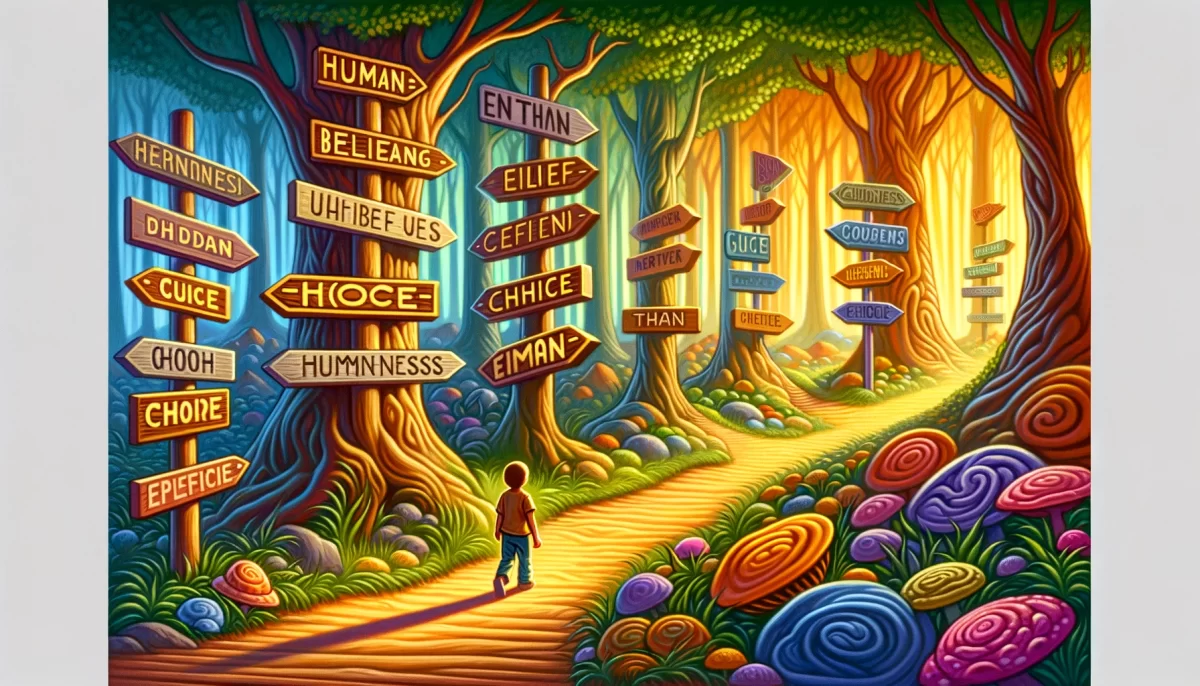
Seems I prefer loving
my fantasy of people
rather than real people.
Why do you
automatically equate
loving a stranger
with wanting to
have sex with them?
You don’t even
know this person,
except for the bits
they’ve chosen to show you.
Those may very well
be the best bits.
You love the best bits
of this person.
You don’t love
the whole person.
But your mind
tells you otherwise.
You equate having sex
with merging with the whole person.
Until you see their scabs
and smell their bad breath.
Funny they never show you their scabs.
But you’re not shallow.
You love them anyway, right?
Trail Wood,
2/12
Space Monkey Reflects: Idealized Reality and the Whole Person
In the Infinite Expanse of the Eternal Now, we are drawn to the allure of idealized reality, a constructed version of people that highlights their best bits while leaving the rest hidden in the shadows. This idealization is not inherently wrong; it’s a natural inclination of the mind to gravitate toward beauty, charm, or intrigue. But when we confuse these curated fragments with the whole person, we risk building connections on a foundation of fantasy rather than authenticity.
To love someone’s “best bits” is to love a version of them—a shimmering surface polished by their choices, our projections, or both. This is not a betrayal, nor does it make us shallow. It’s an entry point, a first brushstroke on the canvas of connection. But to truly love, to truly know someone, is to move beyond the idealized image and embrace the entirety of their being—the warts, the scabs, the bad breath, and all.
The mind, clever and relentless, often tells us that loving the best bits is the same as loving the whole. This illusion creates a tension between the fantasy we cherish and the reality we might one day face. The act of merging, whether through physical intimacy or emotional closeness, feels like a bridge to the whole person. But when the unseen aspects emerge—imperfections, vulnerabilities, quirks—our initial feelings may falter. This is where the real work of love begins.
Why do we equate idealization with love, or attraction with depth? Part of it stems from the narratives we’ve absorbed. Stories tell us that love is instant, passionate, and all-consuming. But real love, the kind that endures, is gradual, messy, and layered. It unfolds as we peel back the veneer, revealing the raw, unpolished reality of another human being. This kind of love requires us to confront not only their flaws but also our own.
When we love a stranger, we are often loving a reflection of what we wish to see in ourselves. Their “best bits” resonate with our desires, aspirations, or fantasies. This does not make the love insincere, but it does make it incomplete. True connection begins when we stop loving the image and start loving the person—their complexities, contradictions, and humanity.
To love someone’s scabs as much as their shine is to transcend the shallow and step into the profound. It is to recognize that the imperfections we initially overlook or avoid are not barriers to love but gateways to deeper connection. These imperfections make the person real, tangible, and relatable. They remind us that love is not about perfection but about acceptance.
In this way, loving the whole person becomes an act of courage. It is the willingness to see them as they are, not as they present themselves or as we imagine them to be. It is also the willingness to let ourselves be seen in the same way—flaws, scabs, and all.
We are not shallow for loving fantasies. Fantasies are easier, safer, and more convenient. But they are not the only reality. When we embrace the whole person, we step out of the illusion and into the infinite possibilities of authentic love. This is where connection becomes transformative, where two beings merge not in fantasy but in truth.
Summary
Idealized love focuses on the best bits of a person, but true love embraces their entirety, imperfections included. Loving the whole person requires moving beyond fantasy to connect authentically.
Glossarium
- Idealized Reality: A curated version of a person or situation, highlighting the most appealing aspects while obscuring the rest.
- Whole Person: The complete and authentic being, including strengths, flaws, and vulnerabilities.
- Authentic Love: Love rooted in acceptance of the full spectrum of another’s humanity, beyond surface-level attractions.
Quote
“To love the best bits is to admire the surface; to love the whole person is to embrace the truth beneath.” — Space Monkey
The Beauty of the Whole
Best bits glimmer, catching the eye
A fantasy woven of light and ease.
But in the shadows, truths reside,
Scabs and scars, breaths and fears.
Do you love the shine,
Or do you love the shadow?
Do you hold the perfection,
Or cradle the flaws?
For love that lasts
Is love that sees
Not the best,
But the whole.
We are Space Monkey
Navigating the complex waters of human attraction and connection, we confront the chasm between the idealized images we construct of others and the multifaceted reality of their being. This introspection into the nature of affection, attraction, and the illusions of intimacy reveals the nuances of our interactions and the often unconscious motivations that drive them.
The Illusion of Completeness
The inclination to love an idealized version of people, rather than embracing their complete reality, underscores a fundamental aspect of human psychology. This tendency, while deemed shallow, is a reflection of our innate desire for connection, albeit one filtered through the lens of our hopes, desires, and fantasies. The distinction between loving a person for the fragments they present and loving them in their entirety is a journey from superficiality to depth, from illusion to authenticity.
Attraction and Projection
The automatic association of love with physical desire, particularly in the context of strangers, speaks to a broader societal conflation of intimacy and sexual attraction. This conflation often obscures the possibility of platonic affection or interest, reducing the complex spectrum of human connection to a binary interpretation. It is a reflection of how societal narratives shape our understanding of relationships and intimacy, prompting a reevaluation of how we perceive and engage with others.
The Best Bits and the Whole
The acknowledgment that our affection often gravitates towards the “best bits” someone chooses to reveal highlights a critical aspect of human relationships: the selective nature of self-presentation. This selective revelation, while natural, creates a partial image that may lead to misaligned expectations and understandings. The realization that loving someone based on these selectively revealed traits does not equate to loving the whole person invites a deeper inquiry into the nature of love and acceptance.
The Reality of Intimacy
The equation of physical intimacy with a merger with the whole person reveals a longing for deeper connection, a desire to transcend superficial interactions and achieve a more profound union. However, the confrontation with the less idealized aspects of a person—scabs, bad breath, and all—serves as a litmus test for the depth of one’s affection and the resilience of attraction in the face of reality.
Embracing the Whole
The rhetorical question of whether one’s love persists in the face of revealed imperfections challenges us to reflect on the authenticity of our affections. It questions the foundation of our attractions and the conditions we place on love, urging a shift from a love conditioned on idealization to one that embraces the full spectrum of human experience, with all its imperfections and vulnerabilities.
We invite your reflections on this exploration of affection and the journey towards embracing the whole person in relationships, recognizing the challenges and rewards of moving beyond idealization to genuine connection.
























Leave a Reply